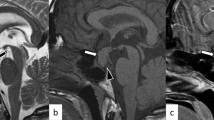Abstract
Adipsic hypematremia, a rare disorder, usually secondary to a hypothalamic lesion, is caused by the combination of partial central diabetes insipidus with hypo-or adipsia. We studied a patient who presented with a global hypothalamic dysfunction including adipsic hypematremia. An extensive work-up disclosed the presence of pseudotumor cerebri and an empty sella turcica. Although endocrine abnormalities including true diabetes insipidus have been reported in conjunction with pseudotumor cerebri or an empty sella, no patient described presented such a global hypothalamic dysfunction or adipsic hypematremia. The increased intracranial pressure is postulated to be the responsible mechanism for both the empty sella and the hypothalamic dysfunction.
Similar content being viewed by others
References
Robertson G.L., Aycinena P., Zerbe R.L. Neurogenic disorders of osmoregulation. Am. J. Med. 72: 339, 1982.
Welt L.G. Hypo- and hypernatremia. Ann. Intern. Med. 56: 161, 1962.
Reuter A.M., Hendrik J.C., Franchimont P. Mise au point d’un dosage rapide des gonadotrophines. Ann. Biol. Clin. 31: 479, 1973.
Skowsky W.R., Rosenbloom A.A., Fisher D.A. The use of thyroglobulin to induce antigenicity to small molecules. J. Lab. Clin. Med. 80: 134, 1972.
Robertson G.L., Mahr E.A., Athar S., Sinha T. Development and clinical application of a new method for the radioimmunoassay of arginine vasopressin in human plasma. J.Clin. Invest. 52: 2340, 1973.
Halter J.B., Goldberg A.P., Robertson G.L., Porte D. Selective osmoreceptor dysfunction in the syndrome of chronic hypernatremia. J. Clin. Endocrinol. Metab. 44: 609, 1977.
De Rubertis F.R., Michelis M.F., Davis B.B. “Essential” hypernatremia. Arch. Intern. Med. 134: 889, 1974.
Ahlskog J.E., O’ Neill B.P. Pseudotumor cerebri. Ann. Intern. Med. 97: 249, 1982.
Weisberg L.A. Benign intracranial hypertension. Medicine (Baltimore) 54: 197, 1975.
Foley K.M., Posner J.B. Does pseudotumor cerebri cause the empty sella syndrome? Neurology 25: 565, 1975.
Smith D.J., Kohler P.C., Helminiak R., Carroll J. Intermittent Cushing’s syndrome with an empty sella turcica. Arch. Intern. Med. 142: 2185, 1982.
Cupps T.R., Woolf P.D. Primary empty sella syndrome with panhypopituitarism, diabetes insipidus and visual field defects. Acta Endocrinol. (Kbh.) 89: 445, 1978.
Brisma K., Effendie S. Pituitary function in the empty sella syndrome. Neuroendocrinology 32: 70, 1981.
Stuart C.A., Neelon F.A., Lebovitz H.E. Hypothalamic insufficiency: the cause of hypopituitarism in sarcoidosis. Ann. Intern. Med. 88: 559, 1978.
Author information
Authors and Affiliations
Rights and permissions
About this article
Cite this article
Verdin, E., Smitz, S., Thibaut, A. et al. Adipsic hypematremia in a patient with pseudotumor cerebri and the primary empty sella syndrome. J Endocrinol Invest 8, 369–372 (1985). https://doi.org/10.1007/BF03348516
Received:
Accepted:
Published:
Issue Date:
DOI: https://doi.org/10.1007/BF03348516




